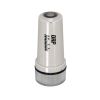Extech ExStik ORP Meter
Features
- Automatic electronic self calibration
- Memory stores and recalls 15 readings and saves last calibrated value
- Data validation indicators show user the reading is stabilized
- Expedited repair and warranty service
- Lifetime technical support
- More
Overview
The Extech ExStick ORP Meter features a flat surface electrode that provides on-the-spot measurements of ORP from -999 to 999mV. The built-in chip automatically recognizes the type of probe plugged in for a specific measurement, and the easy to replace electrode module is interchangeable with pH and chlorine ExStick modules. Other meter functions include data hold, automatic shut-off, and low battery indication.
Benefits
- Automatic electronic self-calibration
- Memory stores and recalls up to 15 readings and saves the last calibrated value
- Simulated analog bargraph displays change in ORP reading based on the sample trends
- Data validation function indicates the reading is stabilized
- IP57 meter floats in water and is protected in wet environments.
- ORP range: -999 to 999mV
- Resolution: 1mV
- Accuracy: +/-4mV
- Measurement storage: 15 tagged (numbered) readings
- Operating conditions: 32 to 122 °F (0 to 50 °C) /< 80% RH
- Display: multifunction LCD with bargraph
- Dimensions: 1.4x6.8x1.6" (35.6x172.7x40.6mm)
- Weight: 3.8oz (110g)
- Warranty: 1 year (meter), 6 month conditional (electrode)
- (1) ExStik meter
- (1) Flat surface ORP electrode
- (1) Protective sensor cap
- (1) Sample cup with cap
- (4) 3V CR2032 button batteries
- (1) 48" (1.2m) neckstrap
In The News
From Paddles to Phytoplankton: Studying Vermont’s Wildest Lakes
For six months of the year, Rachel Cray, a third-year PhD student at the Vermont Limnology Laboratory at the University of Vermont, lives between a microscope and her laptop, running data. For the other six months, she is hiking and canoeing four of Vermont’s lakes, collecting bi-weekly water samples. Cray studies algal phenology across four lakes in Vermont, US, that have low anthropogenic stress—or in other words, are very remote. Funded by the National Science Foundation Career Award to Dr. Mindy Morales, the lakes Cray researches part of the Vermont Sentinel Lakes Program, which studies 13 lakes in the area and, in turn, feeds into the Regional Monitoring Network, which operates in the Northeast and Midwest US.
Read MoreReimagining Water Filtration: How Monitoring and Science Enhance FloWater Filtration Systems
Over 50% of Americans think their tap water is unsafe , according to the Environmental Working Group (EWG). Other recent surveys have found that number to be as high as 70% of persons surveyed. Whether due to increased public awareness of water quality issues or confusion about how municipal water sources are regulated, there is a clear distrust of tap water in the United States. According to industry expert Rich Razgaitis, CEO and co-founder of the water purification company FloWater, this issue creates a damaging cycle. Razgaitis explained that the health and environmental problems associated with contaminated water aren’t the only issues. As people become increasingly aware that some tap water is unsafe, they resort to bottled water.
Read MoreMonitoring New Hampshire’s Aquatic Ecosystems: Continuous Data Collection in the Lamprey River Watershed
New Hampshire’s aquatic ecosystems provide a range of ecosystem services to the state and region. Resources and services like clean water, carbon storage, climate regulation, nutrient regulation, and opportunities for recreation all depend on New Hampshire’s aquatic ecosystems remaining healthy. Jody Potter, an analytical instrumentation scientist at the University of New Hampshire (UNH), is studying these aquatic ecosystems in hopes of developing an improved understanding of ecosystem services and their interactions with climate change, climate variability, and land use changes. [caption id="attachment_39799" align="alignnone" width="940"] Aquatic sensors in the Merrimack River in Bedford, NH, with I-293 in the background.
Read More








